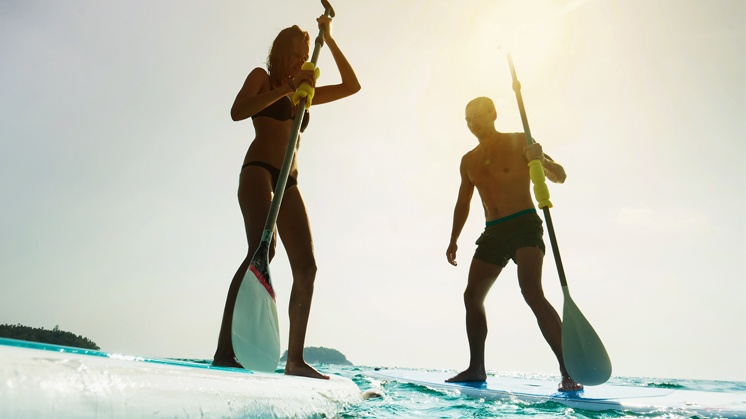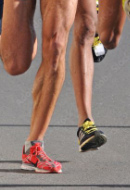Paddle Surf
Stand up paddle surfing: surfing for everyone
Want to try a new outdoor sport? Surfing in calm waters with a board and a paddle is relatively cheap and easy to learn. Let's have some fun!

Stand Up Paddle Surfing, also known as SUP, is a water sport that has gained a lot of popularity in recent years as it is a versatile activity that can be adapted to different skill levels and preferences. It originated on the shores of the Pacific Ocean: the people of Polynesia have relied on it for centuries to travel back and forth between islands. In the 1960s, surfing teachers in Hawaii started using it to monitor their pupils up-close and it is now one of the trendiest water sports.
SUP or Stand Up Paddle Surfing is relatively easy to learn, it is important to take into account the water conditions, such as currents and wind. It is also a complete exercise, which involves working the muscles of the trunk, arms and legs and improves cardiovascular endurance and coordination. Proper paddling technique and balance are essential.
Basic tips on how to enjoy standup paddle surfing
Standup Paddle Surfing, also known as SUP, is a water sport that is gaining a worldwide following thanks to its numerous health benefits. Here we’ll show you everything you need to know to get off to a good start.
- 1
Paddle lenght
With your arm raised, the handle of the paddle should be at wrist level.
- 2
Leash
Always make sure that the leash is attached to one of your ankles.
- 3
First steps
If you are just starting, practice by kneeling on the board before standing up.
- 4
How to hold the paddle
Hold your arms up in a U-shape and this will guide you as to where to place your hands (one of them always on the handle).
- 5
How to position the paddle
The angle of the paddle should be placed forward to maximise the power.
- 6
How to paddle
Put the paddle into the water by positioning the arm holding the handle of the paddle next to your body and extending your other arm forward.
- 7
End of the stroke
Take the paddle out of the water when it is parallel to your feet.
- 8
Changing hands
To avoid mistakes when changing hands, first place the hand in the middle of the paddle and then grasp the handle with the other hand.
-
The board
The key element needed to practice this sport: its shape and volume condition stability and performance.
DeckBottom
-
Body and stance
The perfect stance is with your feet slightly apart, in a straight line with your shoulders. Use the rest of the body to keep your balance.
 SEE INFOGRAPHIC: basic tips on how to enjoy paddle surfing [PDF] External link, opens in new window.
SEE INFOGRAPHIC: basic tips on how to enjoy paddle surfing [PDF] External link, opens in new window.
Keys to practise Stand Up Paddle Surfing
- Board: Larger and wider than a conventional surfboard, which provides stability, they usually measure between 3 and 4 metres. They are made of lightweight materials such as fibreglass, epoxy or plastic. Keep in mind that shorter and wider boards are better to start with.
- Oar: Practitioners use an oar to move through the water. The paddle is usually adjustable in height and has a paddle at one end.
- Stance: feet slightly apart, knees slightly bent, look at the horizon and balance!
- Rowing: use your whole body, not just your arms.

Masters Athletics
Masters athletics is gaining ground.

Trail running
Off-road running: what you need to know.

Triathlon
Triathlon: how to exceed your own limits.

Running
Tips on how to start running.
Stand Up Paddle Surfing Modalities
Stand Up Paddle Surf (SUP) has several modalities that adapt to different preferences and abilities of the practitioners. Some of the most common modalities include:
- SUP surfing:
This mode involves paddling into waves on a SUP board. Paddlers use the paddle to paddle into the waves, and once they have caught a wave, they can use the paddle to keep their balance and steer. - Touring:
SUP touring involves paddling in calmer waters, such as rivers, lakes or coastal waters. It is a relaxed activity that allows paddlers to explore landscapes and enjoy nature. - Race:
SUP races are competitions in which participants race specific distances in the water. They can be races on flat water (such as rivers or lakes) or in open water, and distances vary from sprints to long crossings. - Yoga on SUP:
Some people do yoga sessions on a SUP board. The stability of the boards allows you to practice yoga postures while in the water, providing a unique and challenging experience. - SUP fishing:
SUP fishing combines the relaxing experience of fishing with the mobility and stability offered by a SUP board. Some SUP boards are designed specifically for fishing, with features such as rod holders. - SUP Fitness:
This mode involves performing fitness exercises, such as strength training or cardio workouts, on a SUP board. The instability of the board adds an extra challenge to the exercises, helping to improve balance and core strength. - River SUP:
Consists of paddling in faster, more turbulent waters, such as mountain rivers. It requires advanced SUP skills and knowledge of whitewater paddling techniques. - Downwind Paddling:
This modality involves taking advantage of the winds to paddle in a specific direction. Paddlers choose routes where the wind blows in the same direction they want to paddle, making it easier to get around.
These modes show the versatility of Stand Up Paddle Surfing and how it can be adapted to different preferences and water conditions. Each mode offers a unique experience, making SUP appealing to a wide variety of people with different interests and skill levels.
Precautions when practising SUP
Stand Up Paddle Surfing (SUP) can be a safe and fun experience, but it is important to take certain precautions to ensure safety throughout the activity, so keep some of the following points in mind:
- Check the local weather forecast: make sure you know how strong the wind is blowing and how rough or calm the sea is.
- Get to know the beach well: winds, currents, underwater rock formations, etc.
- Start out paddling into the wind: this way, on your return, things will be easier on the way back when you are already tired.
- Be careful close to the shore: crashing waves as you enter or leave the water can be dangerous.
- Take water with you to stay hydrated. Also, be aware of your energy level and eat adequate food before the session.
- Lifejacket and sunscreen: absolutely essential.
- Stay away from areas with heavy boat traffic to avoid collisions.
- Inform someone of your plans, especially if you are paddling alone. Make sure you have some means of communication, such as a mobile phone in a waterproof bag.
Interested? Let’s get paddling!














